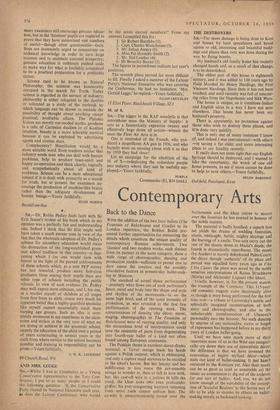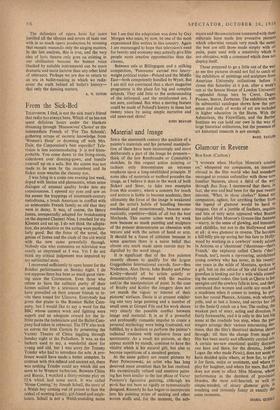Contemporary Arts
Back to the Dance
WITH the addition of the two later ballets (The Fountain of Bakchisarai and Giselle) to its London repertoire, the Bolshoi Ballet pre- sented further opportunities for measuring the details which constitute the unique quality of contemporary Russian achievement. Two 'classics' and two modern works, each distinct from its partner in the same category, show a wide range of choreographic, dancing and production modes—sufficient to permit one to dare assess the creative and the possibly retardative factors in present-day ballet-mak- ing in Moscow.
The standard of actual dance performance —precisely what flows out of each performer's heart, mind and body into the shape and style and rhythm of the movements—is on the same high level, and of the same intensity of projection, as was revealed in the first few performances of the opening week. The appurtenances of dancing (the decor, music, staging, choreography) in The Fountain of Bakchisarai were of varying quality, and only the miraculous level of interpretation could save the ensemble of parts from degenerating into fourth-rate ballet of a kind not often found among European companies.
The Pushkin theme is excellent dance-drama material; a Tartar savage leads his horde against a Polish outpost, which is obliterated, and only a captive maid survives to be enrolled in the khan's harem. But her beauty and her indifference to him rouse thb not-unnoble savage to wonder at. then to fall in love with, her. His cast-off wife in a jealous lit kills the maid; the khan sinks into even profounder glolom; his ever-conquering warriors returning from more raids cannot enliven him. The ex-wife is unceremoniously tossed over the battlements and the khan retires to mourn over the fountain he has erected in honour of the noble maiden.
The material is badly handled; a superb first act yields the drama of wedding festivities, alarm, onslaught, battle, mighty slayings and the burn* of a castle. Two acts carry out the rest of the drama down to Maria's death; the fourth is dramatically superfluous. The music (by Asafiev) is merely dehydrated Palm-Court; the decor though 'authentic' of its place and period was equalled forty years ago in Chu Chin Chow; the piece was saved by the nobly sensitive interpretations of Raissa Struchkova (Maria) and Alexander Lapauri (the khan).
'Giselle, however, is. for the present season, the triumph of the Company. This 115-year- old romantic tragedy came theatrically alive as though it were being performed for the first time ever—a tribute to Lavrovsky's subtle and splendidly imagined reconstruction of both story and choreography, and also to the unbelievable transformation of Ulanova's personality into the heroine. No such dancing by anyone of any nationality, status or length of experience has happened before in my thirty years of London ballet-going.
Until we have seen much more of their repertoire none of us in the West can categori- cally cry down their use of naturalistic décor; the difference is that we have invented the convention of highly stylised decor—which suits our kind of ballet-making. It just hasn't occurred to the Russians yet. Also their music can be as good as (and as unsuitable as) the music we commission or dig out of the archives for our sort of ballets. And, too, we do not know enough of the suitability of the concep- tion of 'Socialist Realism' to the Soviet way of life to be able to dismiss its effects on ballet- making merely as backward-looking.
The defenders of opera have for years justified all the idiocies and errors of taste met with in so much opera production. by stressing that mutatis mutandis only the singing matters. In the last analysis, this is true, and the very idea of lyric theatre only goes on existing in our civilisation because the human voice (backed by suitable instruments) can be more dramatic and more incisive than any other kind of utterance. Perhaps we are due to return to an era in ballet-making in which we redis- cover the truth behind all ballet's history— that only the dancing matters.
A. V. COTON











































 Previous page
Previous page